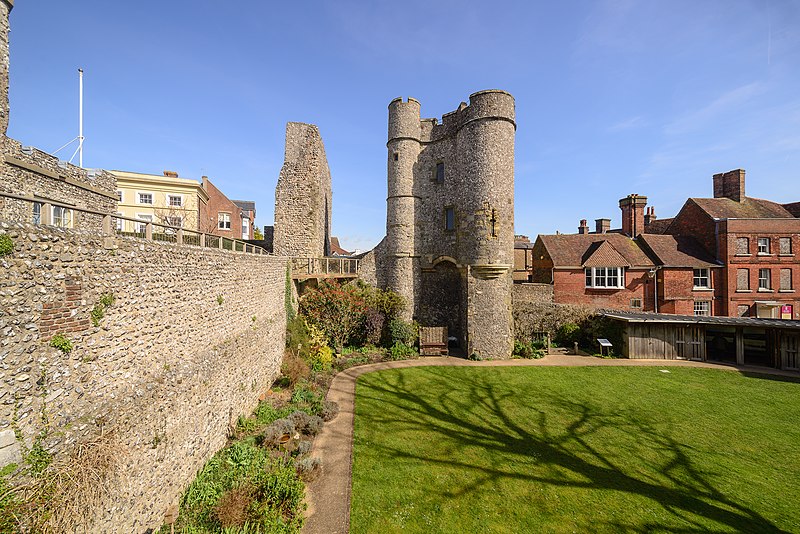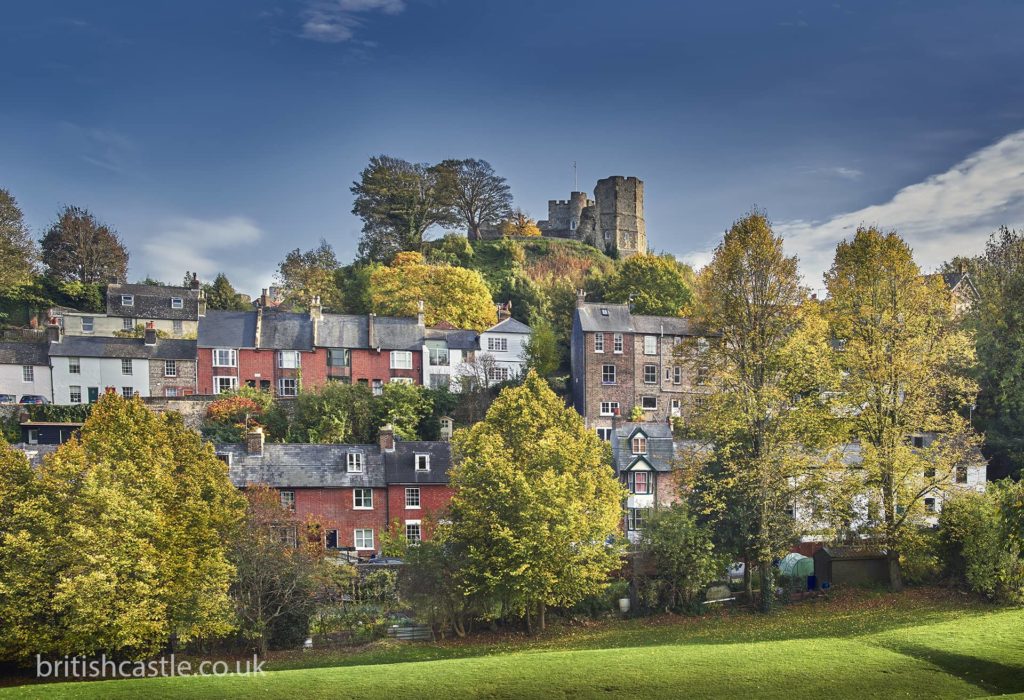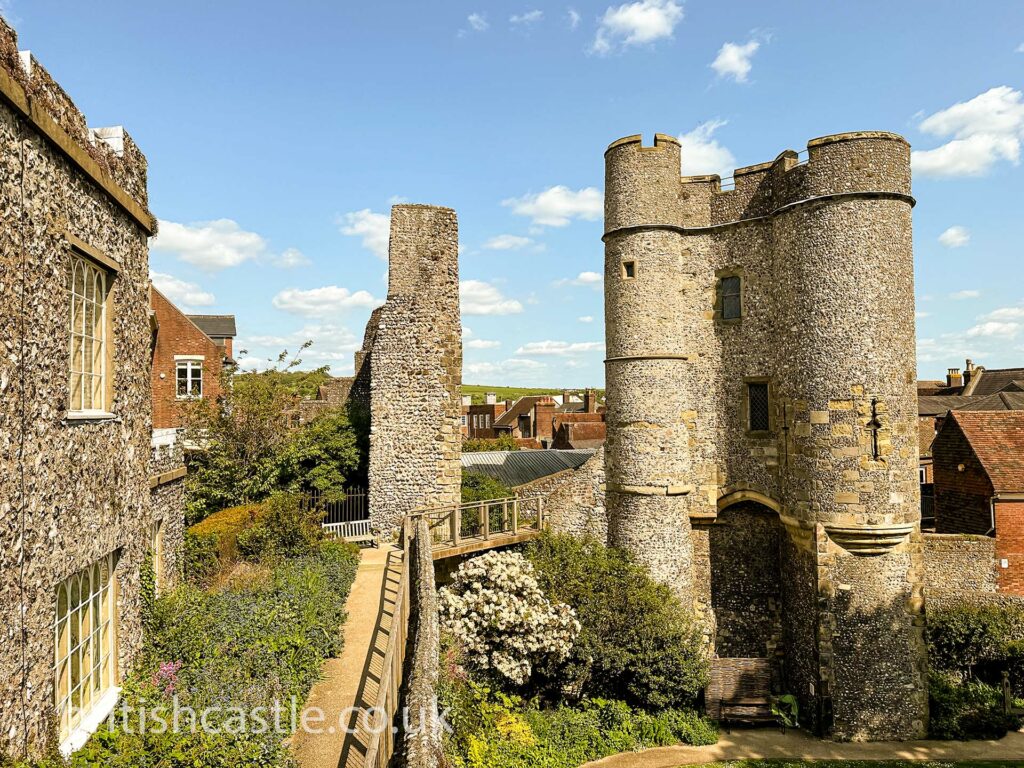Lewes Castle, located in the south-eastern region of England, towers over the surrounding Saxon town of Lewes, the river Ouse, and the forest of East Sussex. The castle is located off a side street along the High Street in Lewes, East Sussex.
It rests on a man-made mound with blocks of native chalk at its core and, like many castles in Britain, particularly those of motte and bailey construction, it dates back to the Norman Conquest of 1066. Lewes Castle was one of the first castles built in England following the Norman Conquest in 1066. The original fortification was named Bray Castle.

Today, the oval shaped bailey has been partially built upon, as town development encroaches the castle boundary and damage and decay over the centuries and looting of the castle for building material has left many of the original buildings in ruins. The defence system of Lewes Castle included a drawbridge and a deep dry ditch. During the 18th and 19th centuries, arrow slits in the West Tower were replaced with Gothic-style windows, enhancing both the aesthetics and functionality of the structure.
However, evidence does remain of the castle’s two mottes, quite unusual in England. Lewes Castle has a unique motte and bailey structure with two mottes. In fact, the only one other example of a double-motte castle to be found in England is Lincoln Castle.
The smaller motte, Brack’s Mount, is though to be the first constructed. It is at the north east end of the bailey and only fragments remain. The first motte, known as Brack Mount, was constructed as a wooden fortress. The larger, in the south west, is mostly intact. The best-preserved part of the castle is the magnificent barbican, one of the best in England.
Introduction to Lewes Castle
Lewes Castle is a Norman fortress in the heart of Lewes, East Sussex, England. Started by William de Warenne shortly after the Norman Conquest in 1066, this is one of the first castles built after the Battle of Hastings. As a Motte and Bailey castle Lewes Castle has two mottes within its oval bailey. The castle has a long history and is closely tied to the Sussex Archaeological Society who have been looking after it since the 19th century. Visitors to Lewes Castle can explore the castle grounds, including the wonderful Barbican House Museum and find out about the castle and the town of Lewes.
Lewes Castle History
Construction on Lewes (Bray) Castle was begun by William de Warenne in 1087. He built Lewes Castle between 1067 and 1070 in the Norman motte and bailey style. William de Warenne also founded the first Cluniac priory in England nearby. The brother-in-law of William the Conqueror, he had been granted the title of 1st Earl of Surrey and awarded a substantial amount of land in the area. In addition to building the castle, he started Lewes priory nearby. The original castle was a wooden fortress located on Brack Mount; a wooden tower with a palisade (fence of wood often used with earthworks). The second motte was constructed opposite the original one. It was surrounded by a moat for extra defence.

In the late 12th century, Hamelin de Warenne (Plantagenet), 5th Earl of Surrey, built a circular shell keep from flint rubble. It is located on the south-western motte and is approximately 110 feet by 100 feet.
A shell keep has a strong wall built on top of the motte; buildings are added against the wall, forming a central courtyard. This type of keep does not have a tower for retaliation during attacks, but is primarily a defensive enclosure. Fragments of knapped flint set in herringbone masonry still remain, reflecting Norman masonry techniques.
Battle of Lewes
Lewes Castle played an important part in the Battle of Lewes, one of the two primary battles in the Second Barons’ War. As a result of this battle on May 14, 1264, Simon de Montfort, 6th Earl of Leicester, became the ‘uncrowned King of England’.
The conflict came about when King Henry III refused to honour the Provisions of Oxford, which he had signed with the Barons in 1258. In preparation for the battle, the King was at nearby St. Pancras Priory with the infantry, while his son Prince Edward (who later became Edward I) camped at Lewes castle with the cavalry.

Montfort surprised Edward during the night, taking the high ground of Sussex Downs. Edward successfully commanded the cavalry against Montfort’s troops, but he made the mistake of pursuing a retreating force, allowing Montfort to defeat the rest of the King’s army. Both King and Prince were imprisoned, establishing Montfort as de facto ruler.
In order to be released from prison, the King was forced to sign the Mise or Settlement of Lewes. This document, now lost, set up a council of knights and citizens, often viewed as the first House of Commons. Prince Edward remained captive until he escaped and defeated Montfort in 1265, thus returning full power to the King.
During World War II, the castle served as a lookout point for the Observer Corps.
Architecture and Design
Lewes Castle is a classic Norman Motte and Bailey castle. The shell keep has octagonal corner towers and a 14th century barbican, probably built by John de Warenne the last of the de Warenne earls. The walls have herringbone masonry which dates from the first half of the 12th century. The design reflects the Norman Conquest and the development of Lewes as a town. The barbican with its grand defensive structure and machicolations is a notable feature. Overall the architecture is a mix of Norman and 14th century.
Further developments
During the latter 13th century, two semi-octagonal towers were added to the shell keep, as well as other buildings inside the shell wall. A gate tower added at this time is almost gone now.
The early 14th century saw the construction of the impressive medieval barbican, with its tall gatehouse and narrow arched entrance, by the 8th Earl of Surrey, John de Warenne. The barbican features machicolations, which are openings that allow defenders to drop rocks onto attackers below. He died without an heir in 1347, and the Castle went to the Earls of Arundel, who left it to decay. Forty years later, a riot further damaged the Castle, and for many years portions of the structure were used by the local citizens as construction material.
In 1620, many of the buildings that remained were demolished. The Keep was spared, however, and was given to Thomas Friend in 1733. It was renovated as a summer house in 1774. The South Tower features a spiral staircase providing access to the upper floors and roof.
Currently, the Castle is the property of Sussex County Historical Society. Lewes Castle remains preserved under the care of the Sussex Archaeological Society today.
Preservation and Restoration
The preservation and restoration of Lewes Castle has been going on since the 19th century. The Sussex Archaeological Society leased the castle in 1850 and have been looking after it ever since. In 1922 Charles Thomas-Stanford, the Chairman of the Society, bought the freehold of Lewes Castle and gave it to the Society. Over the years the castle has had several conservation projects, including the barbican and curtain wall restoration. The Society also has the Museum of Sussex Archaeology next to the castle gate in Barbican House. This museum has exhibits and artefacts about the castle and the town of Lewes and all things Sussex archaeology.
Tourism and Community
Lewes Castle is a popular tourist destination in East Sussex, drawing visitors from around the globe. Open all year, the castle and museum offer a unique and educational experience for all who visit. The castle’s spectacular views of the Sussex countryside and its historic architecture make it a must-visit attraction. The town of Lewes, with its medieval streets and historic buildings, further enhances the visitor experience. The Sussex Archaeological Society offers joint tickets with the nearby Anne of Cleves House, allowing visitors to explore the region’s rich history comprehensively. The castle and museum are also actively involved in community events and activities, including re-enactments and historical festivals. With its rich history, stunning architecture, and beautiful surroundings, Lewes Castle is a treasure of Sussex and a must-visit destination for anyone interested in history, architecture, and culture.